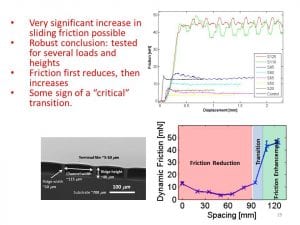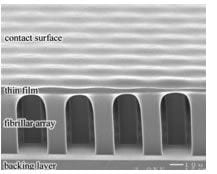Film-terminated Ridge-Channel Structure strongly enhances sliding friction by a mechanism involving internal folding and unfolding as well as unstable release of elastic energy.
He, Zhenping, Chung-Yuen Hui, Benjamin Levrard, Ying Bai, and Anand Jagota. “Strongly modulated friction of a film-terminated ridge-channel structure.” Scientific reports 6 (2016): 26867.


Fibrils with a Roof
As mimics of fibrillar structures found in lizards and ants, we have fabricated and studied a “fibrils with roof” structure. It has significantly enhanced contact compliance and adhesion compared to a flat control sample made of the same material, (poly) dimethylsiloxane, PDMS.

See movies of a control and a fibrillar sample.
See the following and follow-up papers.
“Biologically inspired crack trapping for enhanced adhesion,” Nicholas J. Glassmaker*, Anand Jagota*,† Chung-Yuen Hui‡, William L. Noderer*, and Manoj K. Chaudhury* Proceedings of the National Academy of Sciences , 104 (26) 10786-10791 (2007).
“Enhanced Adhesion and Compliance of Film-Terminated Fibrillar Surfaces”, W.L. Noderer, L. Shen, S. Vajpayee, N.J. Glassmaker, A. Jagota, C-Y. Hui, Proceedings of the Royal Society A , 4632631-2654 (2007).
“Model-Independent Extraction of Adhesion Energy from Indentation Experiments,” Shilpi Vajpayee, Chung-Yuen Hui, Anand Jagota, Langmuir, (2008) 24 (17), 9401-9409.
The “Fibrils with Roof” architecture has strongly enhanced static adhesion. Surprising, at the same time, its sliding friction properties are essentially unchanged.
“Strongly enhanced static friction using a film-terminated fibrillar interface”, Lulin Shen, N.J. Glassmaker, A. Jagota, C.-Y. Hui, Soft Matter 4 [3] 618-625 (2008)
“Mechanism of sliding friction on a film-terminated fibrillar interface,” Lulin Shen, Anand Jagota, Chung-Yuen Hui, Langmuir, 25 (5) 2772-2780 (2009).


